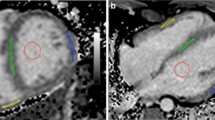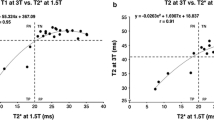Abstract
Background
Myocardial T1 relaxometry can be performed by contouring on individual T1-weighted source images (source method) or on a single T1 map (mapping method).
Objective
This study compares (a) agreement between native T1 and extracellular volume results of the two methods and (b) interobserver reproducibility of the two methods in children without heart disease and those with tetralogy of Fallot (TOF).
Materials and methods
We retrospectively analyzed pediatric patients (controls and those with repaired TOF) with cardiac magnetic resonance examinations including extracellular volume quantification using the modified Look-Locker inversion recovery (MOLLI) sequence. We compared native T1 and extracellular volume of the entire left ventricle and interventricular septum derived using the source and the mapping approaches.
Results
In the control group (n=25, median age 14.0 years, interquartile range [IQR] 11.5–16.5 years), the mapping method produced lower native T1 values than the source method in the interventricular septum (mean difference ± standard deviation [SD] = 12±15 ms, P<0.001). In the TOF group (n=50, median age 13.3 years, IQR 9.9–15.0 years), the mapping method produced lower values for native T1 and extracellular volume in the interventricular septum (mean difference 9±14 ms and 0.6±1.1%, P<0.001). In 6–12% of the children, differences were >3 standard deviations from the mean difference. Interobserver reproducibility between the two methods by intraclass correlation coefficients were clinically equivalent.
Conclusion
T1 and extracellular volume values generated by the source and mapping methods show systematic differences and can vary significantly in an individual child, and thus cannot be used interchangeably in clinical practice. The source method might allow for easier detection and, in some cases, mitigation of artifacts that are not infrequent in children and can be difficult to appreciate on the T1 map.







Similar content being viewed by others
References
Riesenkampff E, Messroghli DR, Redington AN, Grosse-Wortmann L (2015) Myocardial T1 mapping in pediatric and congenital heart disease. Circ Cardiovasc Imaging 8:e002504
Messroghli DR, Moon JC, Ferreira VM et al (2017) Clinical recommendations for cardiovascular magnetic resonance mapping of T1, T2, T2* and extracellular volume: a consensus statement by the Society of Cardiovascular Magnetic Resonance (SCMR) endorsed by the European Association for Cardiovascular Imaging (EACVI). J Cardiovasc Magn Reson 19:75
Burns KM, Byrne BJ, Gelb BD et al (2014) New mechanistic and therapeutic targets for pediatric heart failure: report from a National Heart, Lung, and Blood Institute working group. Circulation 130:79–86
Broberg CS, Chugh SS, Conklin C et al (2010) Quantification of diffuse myocardial fibrosis and its association with myocardial dysfunction in congenital heart disease. Circ Cardiovasc Imaging 3:727–734
Chen CA, Dusenbery SM, Valente AM et al (2016) Myocardial ECV fraction assessed by CMR is associated with type of hemodynamic load and arrhythmia in repaired tetralogy of Fallot. JACC Cardiovasc Imaging 9:1–10
Yim D, Riesenkampff E, Caro-Dominguez P et al (2017) Assessment of diffuse ventricular myocardial fibrosis using native T1 in children with repaired tetralogy of Fallot. Circ Cardiovasc Imaging 10:e005695
Kato A, Riesenkampff E, Yim D et al (2017) Pediatric Fontan patients are at risk for myocardial fibrotic remodeling and dysfunction. Int J Cardiol 240:172–177
Plymen CM, Sado DM, Taylor AM et al (2013) Diffuse myocardial fibrosis in the systemic right ventricle of patients late after mustard or Senning surgery: an equilibrium contrast cardiovascular magnetic resonance study. Eur Heart J Cardiovasc Imaging 14:963–968
Dusenbery SM, Jerosch-Herold M, Rickers C et al (2014) Myocardial extracellular remodeling is associated with ventricular diastolic dysfunction in children and young adults with congenital aortic stenosis. J Am Coll Cardiol 63:1778–1785
Singh A, Horsfield MA, Bekele S et al (2015) Myocardial T1 and extracellular volume fraction measurement in asymptomatic patients with aortic stenosis: reproducibility and comparison with age-matched controls. Eur Heart J Cardiovasc Imaging 16:763–770
Kellman P, Herzka DA, Hansen MS (2014) Adiabatic inversion pulses for myocardial T1 mapping. Magn Reson Med 71:1428–1434
Koo TK, Li MY (2016) A guideline of selecting and reporting intraclass correlation coefficients for reliability research. J Chiropr Med 15:155–163
Dawson B, Trapp RG (2004) Basic and clinical biostatistics, 4th edn. Lange Medical Books/McGraw-Hill, New York
Xue H, Shah S, Greiser A et al (2012) Motion correction for myocardial T1 mapping using image registration with synthetic image estimation. Magn Reson Med 67:1644–1655
Burt JR, Zimmerman SL, Kamel IR et al (2014) Myocardial T1 mapping: techniques and potential applications. Radiographics 34:377–395
De Meester de Ravenstein C, Bouzin C et al (2015) Histological validation of measurement of diffuse interstitial myocardial fibrosis by myocardial extravascular volume fraction from modified look-locker imaging (MOLLI) T1 mapping at 3 T. J Cardiovasc Magn Reson 17:48
Messroghli DR, Plein S, Higgins DM et al (2006) Human myocardium: single-breath-hold MR T1 mapping with high spatial resolution — reproducibility study. Radiology 238:1004–1012
Pica S, Sado DM, Maestrini V et al (2014) Reproducibility of native myocardial T1 mapping in the assessment of Fabry disease and its role in early detection of cardiac involvement by cardiovascular magnetic resonance. J Cardiovasc Magn Reson 16:99
Sado DM, Maestrini V, Piechnik SK et al (2015) Noncontrast myocardial T1 mapping using cardiovascular magnetic resonance for iron overload. J Magn Reson Imaging 41:1505–1511
Liu S, Han J, Nacif MS et al (2012) Diffuse myocardial fibrosis evaluation using cardiac magnetic resonance T1 mapping: sample size considerations for clinical trials. J Cardiovasc Magn Reson 14:90
Rogers T, Dabir D, Mahmoud I et al (2013) Standardization of T1 measurements with MOLLI in differentiation between health and disease — the ConSept study. J Cardiovasc Magn Reson 15:78
Ide S, Riesenkampff E, Chiasson DA et al (2017) Histological validation of cardiovascular magnetic resonance T1 mapping markers of myocardial fibrosis in paediatric heart transplant recipients. J Cardiovasc Magn Reson 19:10
von Knobelsdorff-Brenkenhoff F, Prothmann M, Dieringer MA et al (2013) Myocardial T1 and T2 mapping at 3 T: reference values, influencing factors and implications. J Cardiovasc Magn Reson 18:53
Kellman P, Arai AE, Xue H (2013) T1 and extracellular volume mapping in the heart: estimation of error maps and the influence of noise on precision. J Cardiovasc Magn Reson 15:56
Ferreira VM, Piechnik SK, Dall’Armellina E et al (2012) Non-contrast T1-mapping detects acute myocardial edema with high diagnostic accuracy: a comparison to T2-weighted cardiovascular magnetic resonance. J Cardiovasc Magn Reson 14:42
Kellman P, Wilson JR, Xue H et al (2012) Extracellular volume fraction mapping in the myocardium, part 1: evaluation of an automated method. J Cardiovasc Magn Reson 14:63
Kellman P, Wilson JR, Xue H et al (2012) Extracellular volume fraction mapping in the myocardium, part 2: initial clinical experience. J Cardiovasc Magn Reson 14:64
Author information
Authors and Affiliations
Corresponding author
Ethics declarations
Conflicts of interest
None
Additional information
Publisher’s note
Springer Nature remains neutral with regard to jurisdictional claims in published maps and institutional affiliations.
Electronic supplementary material
ESM 1
(DOCX 2674 kb)
Rights and permissions
About this article
Cite this article
Lam, C.Z., Pagano, J.J., Yim, D. et al. Mapping versus source methods for quantifying myocardial T1 in controls and in repaired tetralogy of Fallot: interchangeability and reproducibility in children. Pediatr Radiol 49, 1152–1162 (2019). https://doi.org/10.1007/s00247-019-04428-y
Received:
Revised:
Accepted:
Published:
Issue Date:
DOI: https://doi.org/10.1007/s00247-019-04428-y




